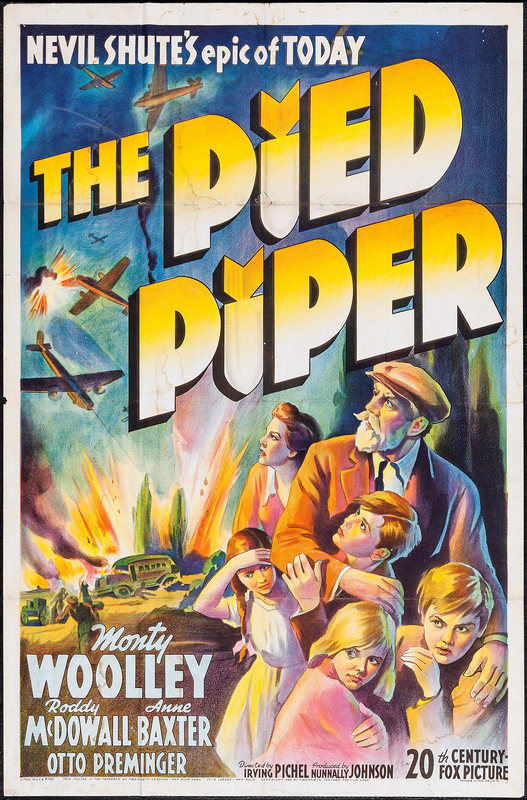The 1942 Best Picture nominee, The Pied Piper, opens in Eastern France, shortly after the outbreak of World War II.
John Sidney Howard (played by Monty Woolley) is an Englishman on holiday. He says that he just wants to enjoy some fishing before the entire continent of Europe descends into chaos. He knows that France is going to be invaded at some point and he even suspects that the country will probably fall to the Nazis. In his 70s and still mourning the death of his son (who was killed during an air battle over occupied Poland), Mr. Howard just wants to enjoy France one last time. Despite the fact that the bearded Howard bears a resemblance to a thin Santa Claus, he’s quick to declare his dislike of both children and humanity in general. He’s a misanthrope, albeit a rather friendly one.
Howard’s plans change when the Nazis invade France sooner than he expected. With his vacation canceled, Howard just wants to get back to England. Complicating matters is that a diplomat named Cavanaugh (Lester Matthews) has asks Howard to take his children, Ronnie (Roddy McDowall) and Sheila (Peggy Ann Garner), back to England with him. Despite his self-declared dislike of children, Howard agrees. However, it turns out that getting out of France won’t be as easy as Howard assumed. After their train gets diverted by the Nazis, Howard, Ronnie ,and Sheila are forced to take a bus. After almost everyone else on the bus is killed in a surprise Nazi attack, Howard and the children are forced to continue on foot and rely on the kindness of a young French woman, Nicole Rougeron (Anne Baxer).
Throughout the journey, Howard keeps collecting more and more children. Everyone wants to get their children to a safe place and Howard soon has a small entourage following him. Unfortunately, he also has Gestapo Major Diessen (an excellent Otto Preminger) watching him. How far is Howard willing to go to ensure the safety of the children?
The Pied Piper is an interesting film, in that it starts out as something of a comedy but it then gets progressively darker as events unfold. At the beginning of the film, it appears that the whole thing is just going to be Howard getting annoyed with the precocious Ronnie and Sheila. But then that bus is attacked and Howard find himself accompanied by a young boy who has been left in a state of shock by the attack. When the group is joined by a young Jewish child named Pierre, it’s a reminder that, though the film itself may have been shot on an American soundstage, the stakes and the dangers in occupied Europe were all too real.
The Pied Piper was nominated for Best Picture of the year. Viewed today, it may seem like an unlikely nominee. It’s a well-made movie and Monty Woolley gives a good performance as John Sidney Howard. It’s the type of film that, due to the sincerity of its anti-Nazi message, should bring tears to the eyes of the most hardened cynic but, at the same time, there’s nothing particularly ground-breaking or aesthetically unique about it. Still, from a historical point of view, it’s not a surprise that this competent but conventional film was nominated. With America having just entered the war, The Pied Piper was a film that captured the national spirit. Other World War II films nominated in 1942 included 49th Parallel, Wake Island, and the eventual winner, Mrs. Miniver.
In fact, one could argue that The Pied Piper is almost a cousin to Mrs. Miniver. Both films are not only anti-German but also unapologetically pro-British. Just as Greer Garson did in Mrs. Miniver, Monty Woolley is meant to be less of an individual and more of a stand-in for Britain itself. When both Mrs. Miniver and Mr. Howard refused to surrender in the face of German aggression, these movies were proudly proclaiming that the British would never lose hope or surrender either.
Thankfully, the movies were correct.



